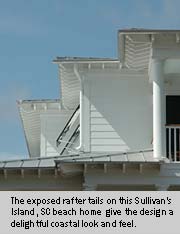
What Makes a Beach House Look Like a Beach House?
Choosing a design for your coastal property presents the opportunity to explore home styles that are a bit more unique than the designs found in most subdivisions. As you search for a coastal or beach house design that fits your lifestyle, you’ll begin to notice that some designs look more “coastal” than others.
In the first of an ongoing series titled “Coastal Design Elements” we’d like to introduce you to the key design components that designers and architects use to give their designs a coastal look and feel. The first of these elements is the exposed rafter tail.
What is a Rafter Tail?

To make sure we’re all on the same page, we’d best define the term rafter. The folks at Sound Home Resource Center (www.SoundHome.com) define a rafter as “The framing member which directly supports the roof sheathing. A rafter usually follows the angle of the roof, and may be a part of a roof truss.” The rafter is typically a 2” x 10” or a 2” x 12”. The rafter tail is the cut end of the rafter that extends to the edge of the roof. Most rafter tails are boxed in by a soffit, so that they are not visible to the eye. Rafter tails that are not boxed in are called “exposed”.
Exposing the roof’s rafter tails was a common practice at the turn of the century, but only for vacation homes and especially for beach houses. Homeowners constructing second homes were looking for ways to lower constructions costs. The homeowner could realize considerable savings by eliminating the cost for the extra material and labor needed to make fully boxed in soffits. The exposed rafter tails created a look that was casual and relaxed – perfect for seaside cottages and lake homes.
As use of the exposed rafter tail became wide spread, creative carpenters embellished the cut end into distinctive shapes including horses heads. If you visit one our nation’s many historic coastal vacation destinations (Nag’s Head, NC, Key West, FL, etc.), you’ll begin to notice the almost pervasive use of the exposed rafter tail.
Pay Attention to the Details to Get that Classic Seaside Cottage Look
These days, the exposed rafter tail is used by designers and architects to recreate the look of the classic turn-of-the-century seaside cottage. Ironically, employing this design feature probably adds cost to the modern construction project due to the care in cutting that is necessary for a presentable exposed board. But, if you’re looking for a design with old-fashioned charm, it’s hard to resist the beauty of the exposed rafter tail.
You’ll see many examples of this iconic coastal design element in our Beach House Plan category. Happy plan surfing!